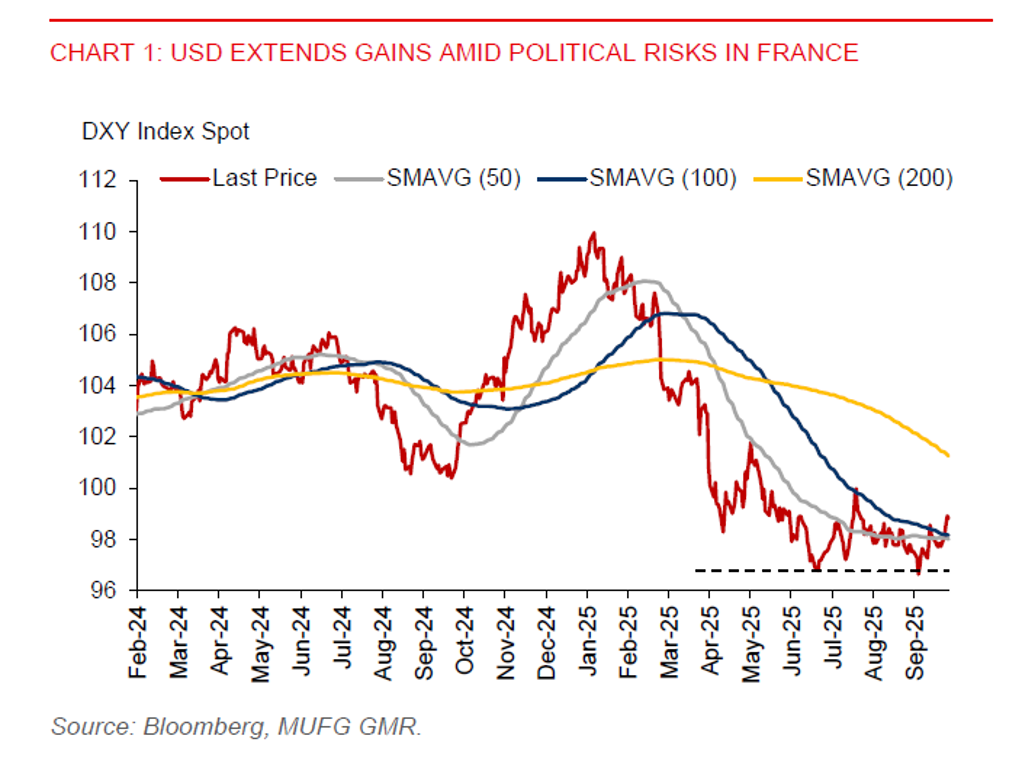Ahead Today
G3: ECB account of Sept rate decision
Asia: BSP policy rate decision
Market Highlights
The US dollar (DXY) has extended its upward momentum, building on firm support around the 96.00–97.00 range, as rising political uncertainty in France continues to weigh on the euro. French President Macron is expected to appoint a new prime minister this week following the brief tenure of outgoing Premier Sebastien Lecornu. However, the leadership change is unlikely to resolve the underlying political instability. The incoming prime minister will face a challenging task of navigating a deeply fragmented parliament and forming a functional cabinet. While Macron has avoided calling a snap election for now, the political gridlock likely remains. Reflecting market concerns, the yield spread between French and German 10-year government bonds has widened sharply to 83 basis points, which is just shy of its December 2024 peak of 88 basis points.
Meanwhile, the minutes from the Fed’s September policy meeting revealed that most officials continue to support further rate reduction this year, given rising risk to the labour market. However, in the near term, political uncertainty in France and a potentially slower pace of rate hikes from the Bank of Japan are reinforcing support for the US dollar.

Regional FX
Asian currencies have broadly softened amid renewed US dollar strength, driven by political risks in Europe and Japan. The recalibration of market expectations around a slower pace of Bank of Japan (BOJ) rate hikes continues to exert downward pressure on the yen, with spillover effects weighing on regional currencies. The yen’s underperformance remains a key anchor for broader Asia FX weakness, especially as investors reassess the likelihood of near-term policy tightening in Japan.
BSP POLICY MEETING IN FOCUS
The key highlight today is the BSP policy meeting. We expect BSP to keep rates on hold, having already delivered successive rate cuts. The central bank has recently adopted a more cautious tone on further easing, particularly as the Philippine peso has weakened. This suggests a pause in easing as BSP monitors inflation and external vulnerabilities.
BOT HOLDS RATES, SIGNALS DOVISH BIAS
Meanwhile, the Bank of Thailand (BoT) held its policy rate steady at 1.50% in Governor Vitai’s debut meeting, with a 5-2 vote split. Two members dissented in favour of a 25bps rate cut, citing the need for more accommodative policy to support credit growth and ease the debt burden on SMEs and vulnerable households. The majority, however, emphasized preserving limited policy space and allowing previous rate cuts to fully transmit through the economy. The BoT’s dovish tone, coupled with a weaker outlook for growth and inflation, suggests that further easing remains on the table, potentially at the December meeting.
Thailand’s macro backdrop remains relatively benign. BOT projects GDP growth at 2.2% in 2025 and 1.6% in 2026. Growth is also expected to slow in the H2 2025, as tariff-related headwinds are likely to intensify. Domestic demand remains subdued, credit growth remains weak, and bank asset quality, particularly for SME loans, has deteriorated. These factors reinforce the case for policy support.
The BoT’s decision to hold rates this month, contrary to market expectations for a rate cut, should help anchor the Thai baht around 32.50 against the US dollar in the near term. Even though the Fed could lower rates further in Q4, any baht appreciation is likely to be constrained by expectations of further policy easing, export risks, and a subdued domestic growth outlook. Notably, the risks for USDTHB are skewed to the upside, especially if global risk sentiment deteriorates.
